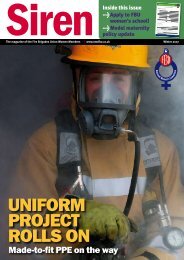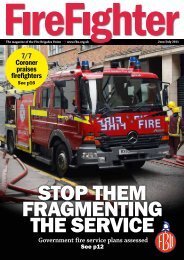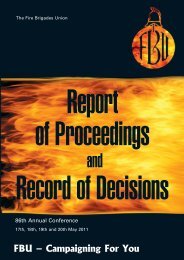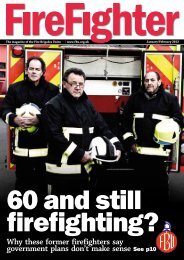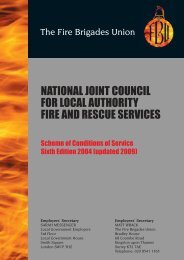Draft London Safety Plan 2010/2013 - Fire Brigades Union London
Draft London Safety Plan 2010/2013 - Fire Brigades Union London
Draft London Safety Plan 2010/2013 - Fire Brigades Union London
You also want an ePaper? Increase the reach of your titles
YUMPU automatically turns print PDFs into web optimized ePapers that Google loves.
other enforcement actions (both formal and informal<br />
according to the risk level found) being taken.<br />
We have written to local authorities and other residential<br />
social landlords on a number of occasions to highlight<br />
landlords’ responsibilities. Our local fire safety teams and<br />
borough commanders work with local housing authorities<br />
and other social landlords to put in place appropriate<br />
programmes to ensure residential property is brought into<br />
compliance with the Order.<br />
Where companies or local authorities have a large<br />
amount of property for which fire risk assessment and<br />
necessary remedial works is necessary, our primary<br />
concern is to bring the premises into compliance with the<br />
law.<br />
Our usual practice, developed through work with local<br />
authorities and major housing providers, is to firstly have<br />
the body concerned prioritise fire risk assessment of their<br />
buildings according to the potential risk to life. This<br />
element of prioritisation will take into account a number<br />
of factors including premises type, construction methods,<br />
use and any other relevant factors such as the presence of<br />
vulnerable people. One particular factor taken into<br />
account is that premises housing large numbers of people<br />
(for example, large residential care homes, hospitals and<br />
blocks of flats) may pose a relatively higher risk of<br />
significant numbers of deaths or serious injuries because<br />
of the numbers of people involved than would exist for<br />
say a row of ground and first floor maisonettes that is<br />
used for sheltered housing but where the number of<br />
people in each property is much smaller.<br />
The process of carrying out remedial works is prioritised<br />
in a similar way but also takes into account the level of risk<br />
identified through the fire risk assessments. Priority is<br />
given to the most risk critical measures and within that to<br />
the most risk critical in the highest potential risk premises.<br />
For both fire risk assessments and remedial works we ask<br />
the body concerned to propose timescales for the<br />
necessary activities. Those timescales need to be<br />
reasonable and for all of the works in a large number of<br />
buildings to be completed can take several years..<br />
However, the fire risk assessment of potentially higher<br />
risk premises and risk critical improvements must be<br />
carried out over a shorter period.<br />
Where agreement cannot be reached, then enforcement<br />
powers can be used to give legally binding effect to the<br />
programme and dates that we consider to be reasonable<br />
in the circumstances.(subject to any legal appeal that may<br />
be lodged).<br />
ENFORCEMENT OPTIONS<br />
The Authority’s policy on determining the level of<br />
enforcement action to take uses nationally recognised risk<br />
assessment based methods. In deciding what action to<br />
take to ensure compliance with the law, the Authority<br />
considers the following:<br />
The nature and seriousness of any alleged offence/s;<br />
The risk of death or serious injury;<br />
Previous experience and record of compliance of the<br />
responsible person;<br />
Action taken to prevent any recurrence;<br />
The likely effectiveness of the various enforcement<br />
options;<br />
Any explanation offered and the circumstances and<br />
attitude of the responsible person; and<br />
Any statutory defence available.<br />
The Authority will always seek to use enforcement action<br />
that is proportionate to the circumstances of the offence<br />
and the risk to life, but in so doing will also consider other<br />
factors such as the size of the business or undertaking<br />
and the nature of its activities.<br />
Choices of enforcement approach available to the<br />
Authority are:<br />
Educate and inform;<br />
Statutory notice identifying the nature of the<br />
corrective action needed;<br />
Prohibition /restriction of use;<br />
Referral to other agencies;<br />
Formal caution; and<br />
Prosecution.<br />
Further details of how these are applied can be found in<br />
the Enforcement policy statement.<br />
THE USE OF FORMAL ACTION<br />
Before formal enforcement action is taken officers will<br />
allow those responsible for complying to make<br />
representations and, where possible, to resolve points of<br />
difference, except when the situation is so serious that<br />
immediate action is necessary. When immediate action is<br />
taken to prohibit or restrict the use of a premises this will<br />
be explained in writing to the relevant party/parties<br />
normally within 24 hours. Where rights of appeal exist<br />
against formal action the Authority will clearly state this,<br />
with advice on the appeal process.<br />
PUBLIC INTEREST FACTORS<br />
The Authority will consider the following factors in<br />
deciding whether or not to prosecute:<br />
23





